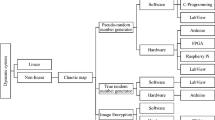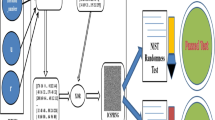Abstract
The telecommunications industry has made huge strides, and multimedia information transmission is exploding. Text, sound, and video can all be used to create multimedia data. As a result, having systems in place to protect private or sensitive data and keep its security is critical. In this article, completely random numbers were generated in two different ways, and the extent of their randomness was tested in many ways to ensure their suitability for use in different cryptographic applications. The proposed models in this article depend on a chaos based Pseudo-random number generators (PRNGs). PRNGs, which create bit sequences, have evolved into a critical component in many industries, including encrypted communication, Wireless communication using a spread spectrum, computational simulations, RF identification networks, and coding for error correction. The PRNGs is designed by combining the memristor that is discrete with the logistic map and the memristor that is discrete with sine map both separately to construct the novel algorithms called a two-dimensional memristive logistic map (2D-MLM) and two dimensional memristive sine map (2D-MSM) and each cycle yields a sequence of 32 random bits. The binary64 dual precision format is employed for arithmetic using floating-point in accordance with the IEEE 754-2008 standard. To assess the generator's performance, several statistical analyses are utilized. The results of the tests that evaluated the presented algorithms showed that the space key was improved and increased by 3.2% compared to other generators, and the performance speed was increased by 12.22%. The findings reveal that the sequences that are created have an elevated degree of unpredictability and a high level of security, which renders them excellent for cryptographic use in terms of the speed, the large key space, and high data rate.








Similar content being viewed by others
Data availability
Data sharing is not relevant to this article since no datasets were created or analyzed during the present investigation.
References
Aljohani M et al (2019) Performance analysis of cryptographic pseudorandom number generators. IEEE Access 7:39794–39805
Guyeux C et al (2015) Efficient and cryptographically secure generation of chaotic pseudorandom numbers on gpu. J Supercomput 71(10):3877–3903
Demir K, Ergün S (2018) An analysis of deterministic chaos as an entropy source for random number generators. Entropy 20(12):957
Wang L, Cheng H (2019) Pseudo-random number generator based on logistic chaotic system. Entropy 21(10):960
Vajargah BF, Asghari R (2015) Cryptographic secure pseudo-random generation: the Chaotic Linear Congruental Generator (CLCG). Sci Int (Lahore) 27
Hamdi M, Rhouma R, Belghith S (2015) A very efficient pseudo-random number generator based on chaotic maps and s-box tables. Int J Comput Electr Autom Control Inf Eng 9(2):481–485
François M, Defour D, Negre C (2014) A fast chaos-based pseudo-random bit generator using binary64 floating-point arithmetic. Informatica 38(2):115–124
Francois M, Grosges T, Barchiesi D, Erra R (2013) A new pseudo-random number generator based on two chaotic maps. Informatica 24:181–197
Singamaneni KK, Dhiman G, Juneja S, Muhammad G, AlQahtani SA, Zaki J (2022) A novel QKD approach to enhance IIOT privacy and computational knacks. Sensors 22(18):6741
Chua L (1971) Memristor-the missing circuit element. IEEE Trans Circuit Theory 18(5):507–519
Chua L (2019) Resistance switching memories are memristors. Handbook of memristor networks, 197–230
Chua L (2014) If it’s pinched it’sa memristor. Semicond Sci Technol 29(10):104001
Bao H, Chen M, Wu H, Bao B (2020) Memristor initial-boosted coexisting plane bifurcations and its extreme multi-stability reconstitution in a two-memristor-based dynamical system. Sci China Technol Sci 63(4):603–613
Bao BC, Li H, Wu H, Zhang X, Chen M (2020) Hyperchaos in a second-order discrete memristor-based map model. Electron Lett 56(15):769–770
Liu M, Zhang S, Fan Z, Zheng S, Sheng W (2013) Exponential H∞ synchronization and state estimation for chaotic systems via a unified model. IEEE Trans Neural Netw Learn Syst 24(7):1114–1126
Li H, Hua Z, Bao H, Zhu L, Chen M, Bao B (2020) Two-dimensional memristive hyperchaotic maps and application in secure communication. IEEE Trans Industr Electron 68(10):9931–9940
Zuras D, Cowlishaw M, Aiken A, Applegate M, Bailey D, Bass S … Canon S (2008) IEEE standard for floating-point arithmetic. IEEE Std 754(2008):1–70
Wolf A, Swift JB, Swinney HL, Vastano JA (1985) Determining Lyapunov exponents from a time series. Physica D 16(3):285–317
Krishnamoorthi S, Jayapaul P, Rajasekar V (2021) A modernistic approach for chaotic based pseudo random number generator secured with gene dominance. Sādhanā 46(1):1–12
Huang X, Liu L, Li X, Yu M, Wu Z (2019) A new two-dimensional mutual coupled logistic map and its application for pseudorandom number generator. Math Probl Eng 2019:1–10
Krishnamoorthi S, Jayapaul P, Dhanaraj RK, Rajasekar V, Balusamy B, Islam SH (2021) Design of pseudo-random number generator from turbulence padded chaotic map. Nonlinear Dyn 104:1627–1643
Nesa N, Ghosh T, Banerjee I (2019) Design of a chaos-based encryption scheme for sensor data using a novel logarithmic chaotic map. J Inf Sec Appl 47:320–328
Murillo-Escobar MA, Cruz-Hernández C, Cardoza-Avendaño L, Méndez-Ramírez R (2017) A novel pseudorandom number generator based on pseudo randomly enhanced logistic map. Nonlinear Dyn 87(1):407–425
Alhadawi HS et al (2019) Designing a pseudorandom bit generator based on LFSRs and a discrete chaotic map. Cryptologia 43(3):190–211
Rukhin A, Soto J, Nechvatal J, Smid M, Barker E, Leigh S, Levenson M, Vangel M, Banks D, Heckert A, Dray J (2001) A statistical test suite for random and pseudorandom number generators for cryptographic applications, vol. 22. US Department of Commerce, Technology Administration, National Institute of Standards and Technology
L’Ecuyer P, Simard R (2007) TestU01: a C library for empirical testing of random number generators. ACM Trans Math Sofw 33(4):1–22
Alvarez G, Li S (2006) Some basic cryptographic requirements for chaos-based cryptosystems. Int J Bifurcat Chaos 16(08):2129–2151
Biham E, Shamir A (2012) Differential cryptanalysis of the data encryption standard. Springer Science & Business Media, New York
Author information
Authors and Affiliations
Corresponding authors
Ethics declarations
Conflict of interest
The authors declare that they have no conflicts of interest.
Additional information
Publisher's Note
Springer Nature remains neutral with regard to jurisdictional claims in published maps and institutional affiliations.
Rights and permissions
Springer Nature or its licensor (e.g. a society or other partner) holds exclusive rights to this article under a publishing agreement with the author(s) or other rightsholder(s); author self-archiving of the accepted manuscript version of this article is solely governed by the terms of such publishing agreement and applicable law.
About this article
Cite this article
Moussa, K.H., Mohy El Den, A.M., Mohamed, I.A.E. et al. Various pseudo random number generators based on memristive chaos map model. Multimed Tools Appl 83, 59561–59576 (2024). https://doi.org/10.1007/s11042-023-17863-9
Received:
Revised:
Accepted:
Published:
Issue Date:
DOI: https://doi.org/10.1007/s11042-023-17863-9




